


|
 |
|
|
#1 |
|
Dr. Reef at ur service
|
Photographic guide to Fish disease, Parasites and common issues.
Hi
there are beautiful forum here on RC for every type of imaginable questions but i noticed there was a need for a photographic guide to disease and parasites in marine/aquarium fish. Some of the following is my own personal research and some taken from other websites. I personally thank everyone here at RC and respective authors of websites from where i was able to gather this information to help everyone. Much has been written on the topic of stress & disease, below is summary to help guide you throughout External Parasites prevention and identification. Please feel free to ask questions and comments and correct me where its needed. EXTERNAL PARASITES Symptoms: Large ugly sores on body Skin looks grey in patches. Fish is lethargic Fins are torn & jagged Fish swim aimlessly. May have spasms. Loss of appetite Fish lays at the bottom of the tank 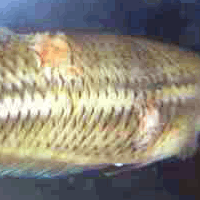 External Parasites General Description Has your fish been stricken by a parasitic invasion? Most likely is a caused by the environment it is currently in or used to live. Making sure the water is very good before dumping various chemicals into the tank is always best. All fish are potential hosts to many different species of parasites. Small numbers of parasites are common and probably do little harm. However, all parasites have tremendous reproductive potential and can, under ideal conditions, quickly overwhelm fish in the confines of a tank or pond. External Parasites Treatments Different parasites often need different treatments. This can be important when more than one species is involved. While general anti-parasite treatments are effective with most parasites, they do not treat all parasites. Sometimes, for various reasons such as under-dosing, water chemistry, organic pollution or green water, treatments do not work. Treatment can be dependent on the following: - Species involved - Whether treatment takes place in display tank or back-up tank - Volume of tank (some drugs may be too expensive) - Value of display organisms (if easily replaced it may be simpler to chlorox the whole tank and start all over) - How dangerous the organism is (if one has parasitic dinoflagellates, the tank is small, and the display organisms are common it is best to kill everything before the parasite spreads). Fresh water dips for saltwater fish and saltwater dips for fresh water fish will dislodge some external parasites. Length of dips will vary per species; usually three-five minute dips will suffice, remove fish if they go into extreme distress. External Parasites Prevention Firstly, we will deal with the prevention of fish diseases. It's best to take the following basic precautions as first step in keeping a healthy aquarium :- 1. Avoid purchasing/adding fishes to your established tank which exhibits the following symptoms :- - Unusual swimming behaviour e.g. tailspin, rapid or jerky movement - Signs of injuries to fins and body. e.g. bleeding, ulcers, skin or fin tear - Not eating. A healthy fish will devour any food gladly - Eyes blurry. Popeye or cloudiness. 2. Pay attention to the fishes for at least a few minutes a day and observe the behaviour. Stressed fishes may exhibit certain unusual behaviour :- - Not eating. - Always hiding, being bullied by other tank mates regularly. - Coming up to the surface to breath regularly, could be a sign of an over-crowded tank or insufficient dissolved oxygen in the water. (in the latter, changing fresh water will help) 3. Ensure the water condition is kept to the ideal level. Check for presence of ammonia and variation in pH (test kits are easily available) at least once a month.Practice regular fresh water changing, make sure the temperature and pH level is similar and not to more than 50% of the water at one time. Avoid cleaning your biological filter all at once, alternate the cleaning. Major Sick Fish Diseases, Parasites and Problems: AMMONIA POISONING Symptoms: Fish gasp for breath at the water surface Purple or red gills Fish is lethargic Fins are torn & jagged Loss of appetite Fish lays at the bottom of the tank Fish may appear darker in color Red streaking on the fins or body 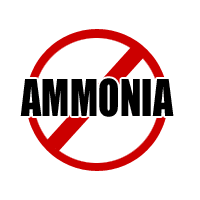 Ammonia Poisoning General Description Ammonia poisoning is one of the biggest killers of aquarium fish. Ammonia irritates the fish by burning there gills and scales and sometimes the scales even fall off. It occurs most often when a tank is newly set up. However, it can also occur in an established tank when too many new fish have been added at one time, when the filter fails due to power or mechanical failure, or if bacterial colonies die off due to the use of medications or sudden change in water conditions. Now when you see a fish that has Black edges on the fish some of the times this is do to the ammonia burning the fish and is in the healing end of it. Nothing to worry about just keep the levels in the tank in a clean environment Ammonia Poisoning Treatments Aquarium Pharmaceuticals Melafix heals open wounds & abrasions, treats fin and tail rot, eye cloud, mouth fungus and promotes regrowth of damaged fin rays & tissue. Will not adversely affect the biological filter, alter the pH, or discolor water. Safe for reef aquariums and live plants. For use in fresh or salt water. Do daily water changes to reduce ammonia levels to 1-2 ppm for freshwater or below 1 ppm for saltwater. Aerate, and make sure pH is at or below 7.0 for freshwater tanks. In addition to or instead of changing water, you can also add a dose of something like AmQuel, but I prefer the water change method. Find out why ammonia is present and correct the problem. Ammonia Poisoning Prevention Stock new tanks slowly, proper cycling. Feed sparingly and remove uneaten food (I'm serious) Change water regularly 20% weekly. Test water regularly. The key to avoiding fish death from ammonia poisoning is to not let the ammonia build up in the first place. Completely cycle the tank before adding fish. Even in an well established tank, avoid overstocking. Feed fish very small quantities of foods. They really don't need much to eat. Gravel wash and change 20% of the water weekly, taking care of fish is a responsibility. ANCHOR WORMS Symptoms: Anchor worms (lernea) can be seen with the naked eye Frequent rubbing or "flashing" Localised redness Ulcers my appear Inflammation on the body of the fish Tiny white-green or red worms in wounds Breathing difficulties Commonly near the base of the fins General lethargy 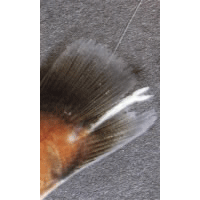 Anchor Worms General Description Anchor worms are parasites that infect fish and one of the main problems with them is that they increase the risk of attracting other diseases. The anchor worms can cause serious damage to a fish and can eventual kill the fish themselves, but anchor worms are only seldom the cause of death in fish with anchor worm since the damage weakens the fish and opens it up for other diseases that end up killing the fish. Anchor worms are in fact small crustaceans. These crustaceans start out their life as free swimming and find a fish to burrow their way into. They burrow themselves too far into the fish to allow for safe removal. When they have buried themselves into the fish they move themselves into the muscles where they live for several months while developing. They then make their way out of the fish, a process that often leaves ugly wounds, and releases their eggs before dying. The circle will then start over again. The wound caused by the crustaceans often gets infected which is one of the main reason this disease can invite so many other diseases to infect the sick fish. The long time the crustaceans spend in the fish also makes it hard to know where this disease was introduced from and if it has been cured. The symptoms of anchor worms include the fish scratching themselves against everything in the tank and white green threads hanging out with inflamed centres on the body of the fish. Anchor Worms Treatments (a)Anchor worms can be treated with potassium permanganate in the community tank (will color the water) or by bathing sick fish in a potassium permanganate solution (10mg per litre) for 20-30 min. Treating the entire community/holding aquarium will as I said color the water and be a little messy but it is still a good idea since it guarantees that no other fish are infected and that the disease doesn't return in a few months by emerging from a fish that is currently showing no signs of infection. If you decide to treat your entire tank you should add 2 mg potassium permanganate to every litre of aquarium water in your tank. (b)Salt dip (c)Formalin dip at 2 to 4 ml Formalin/2.5 gallons of water for 30 minutes, the fish may lose equilibrium and must immediately be transferred to clean, fresh water (d)Modern antiparasitics (such as Disco-worm, Fluke tabs, and Clout) may help. (e)The best treatment is to remove them by hand and quarantine the tank. You may have to do the following a few times. Tweezers work well for removing the anchor worms, try to grip them as close to the wound as possible. Periodically dunk the fish into the bucket of water to let him get a few breaths before continuing. After removing as many as you can see, use stress coat and pray. Anchor Worms Prevention Really the only way to get this is to bring it in from somewhere else, Local Fish Stores that are infected. Be sure to quarantine all new fish and never risk your established tank fish! Also remember to use any and all precautions necessary to protect you and your fishy friends when working with harmful chemicals. CATARACTS Symptoms: Thin white covering of eyes Can also be grayish On the eyes only Looks kinda foggy like Tendency to bump into things 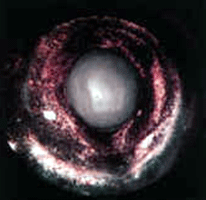 Cataracts General Description A cataract is a lens that has become opaque and does not transmit light efficiently. While not common, this condition does occur in fish. Causes include nutritional deficiency, trauma and hereditary factors. Providing a balanced diet with food that is fresh (commercial food less than 6 months old) can help prevent cataracts. Cataracts Treatments This is difficult to cure. Sorry. I have heard of, the only treatment specifically designed for this ailment is Eye Fungex by Aquatronics. But I can't endorse it, I've never used it. Cataracts are fungal growths on the eyes. Treatment with any aquarium fungicide should work, but it's risky. The eyes are important. Cataracts Prevention Keep that tank clean of fungus! COTTON MOUTH Symptoms: Loss of appetite White spots on mouth, scales, and fins Cottony growth on mouth Fins disintegrate beginning at the edges Looks like a small cotton ball  Cotton Mouth General Description Grayish white marks or patches on the body of the fish or around its mouth are the first obvious signs of Columnaris. These patches appear like threads, especially in the vicinity of the mouth. Hence, this is often confused with another disease called "Mouth Fungus". The fins of the fish may show signs of deterioration, the gills get affected and slowly sores start appearing on the body. During a later stage the fish can hold its fins very close to the body and not spreading them. Columnaris disease is caused by bacteria, and is mostly a direct result of poor water quality. Sometimes, the shock of being introduced to the new aquarium leads to Columnaris disease in newly imported fish. Anti-bacterial medications will be enough if the disease is discovered and treated at its early stages. The disease will however invade the internal organs during the later stages and antibiotics are then required to cure it. Cotton Mouth Treatments Hard to treat, but not impossible. Like any disease best caught early. There are commercial products available to treat cotton mouth. Also change the water daily 20% and use a regular dose of salt in your tank. Cotton Mouth Prevention Usually this comes in with the fish directly from the pet store, or shipment. Because the bacteria thrive on organic wastes, it can be controlled by regular water changes and vacuuming of the gravel. Proper diet and maintaining good water quality in general will keep the fish from being stressed and therefore susceptible to infection. Skin / Gill Flukes Symptoms: Fish gasps for air at the water's surface Gills open and close rapidly Gills are covered in mucus Part of gills may be eaten away Scraping & Flashing 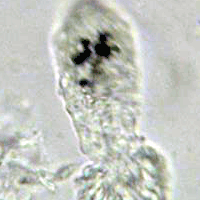 Skin / Gill Flukes General Description Gill disease make the fish appear to be swimming in a great hurry, but it does not move at all. The fins flap very fast, and the fish gasp for breath at the surface, or lie listless at the bottom. The gills become swollen and discolored. Bacteria, fungi and parasites in water can cause gill disease. The first step in the treatment is therefore an immediate improvement in water quality. Frequent water changes, conditioning and dechlorinating the water to ensure its quality are steps to take to threat and prevent gill disease. The chlorine in water often irritates the gills of the fish. Skin / Gill Flukes Treatments Flukes are hard to treat and complete eradication is virtually impossible. For individuals affected with flukes, consecutive salt baths over 2-3 days can be useful. Skin / Gill Flukes Prevention Make sure the water is of a high quality, check pH and ammonia levels. White Spot Ick) Symptoms: Small white grains of saltlike spores all over body White pimples concentrated mainly on the fins Rubbing up against other objects Slimy skin due to heavy mucus layer Abnormal swimming behaviour Breathing difficulties Lethargy and loss of appetite Fraying fins and/or cloudy eyes 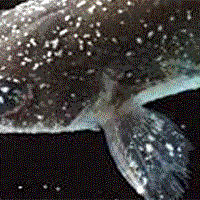 White spot or ick General Description Ick is a disease that causes your fish to get small, grain-like spots on their body. Ick is also known as White Spot Disease or Ich. The fish may try to rub itself against the décor or the hard surfaces in the aquarium, giving an impression of scratching an itch. In freshwater, this disease is caused by protozoa named Ichthyophthirius Multifilis and is very contagious. The parasite spends a part of its life within the skin of the fish, where they form the white spots. These are the cysts. Once the cysts mature they fall down to the substrate and give rise to thousands of new free-swimming parasites that are free to prey upon other fish. An outbreak of Ick is very difficult to control if not noticed in the earlier stages. Since the parasite is released into the aquarium, the entire aquarium has to be treated White spot or ick Treatments (a) Hypo-Salinity (b) Copper Treatment (c) Tank Transfer Method. White spot or ick Prevention Ich can be introduced into the aquarium via infected water, plants, substrates or fish. Some fish can in fact carry the parasite without actually ever being diseased themselves. These carriers shed the parasite into a new aquarium and expose other fish to it who may not have a natural immunity and thus become infected. Therefore, there are some very simple precautions which can prevent ich being introduced: (a)Dont buy any fish from a tank in which ich (or any other disease for that matter!) is obviously present. (b)Quarantine all new fish for at least a month before introducing them to the main tank or pond. Treat with cooper or hypo just in case. (c)Dont add any pet store water to your tank: do the usual temperature and water chemistry adjustments for new fish in a separate bucket and then net the fish out to put it in the tank/pond, leaving the pet store water to be thrown away. (d)Disinfect any new plants, ornaments and substrates with a bleach or potassium permanganate solution before placing them in the tank. DROPSY Symptoms: Big fat belly, not pregnant Huge Swelling of Body Bulging sides and stomach Scales almost popping off Scales may be forced outward Eyes may pop out 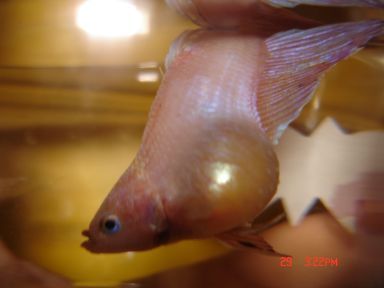 Dropsy General Description Dropsy is not really a disease. For all intensive purposes we will call it one. It's really an internal bacterial infection usually caused by poor water quality. Fish may recover with no treatment and may die despite it. There are multiple possible causes. Sometimes it's not contageous, but sick fish should be isolated and treated since determining the actual cause may be impossible. The swelling is because the fish is absorbing water faster than it can eliminate it, and it can be caused by many different problems. High nitrates are one thing to check. Internal bacterial infections, including fish TB, are other possibilities. If there are no water quality problems, you may want to attempt antibiotic treatment in a separate tank. There are multiple possible causes. Usually caused by kidney damage. Kidney damage may be caused by overuse of drugs or a disease. Eventually the swelling will cause the scales to raise, giving the fish what is called the "pine-cone" appearance. You can best see this by viewing your fish from the top. Fish may also stop feeding, appear off-colour, become listless and/or lethargic, have sunken eyes, and hang at the top or stay at the bottom of the aquarium. Dropsy Treatments Dropsy is not very contagious; however, Fish usually die from this, but in some cases where the problem is due to bacteria, if detected early enough, it can be treated. It's possibly the hardest internal bacterial infection to cure. There are a number of medications available such as penicillin, tetracycline and naladixic acid. The fish usually doesn't make it. By the time the scales begin to raise, however, it is very fatal to the fish. Salt baths can help to draw the fluid out of the fish. A variety of medications can be purchased that treat dropsy, which sometimes occurs due to an internal bacterial problem. Medications for external bacterial problems only will not be effective for this problem. Dropsy Prevention Poor water conditions are often the culprit. High nitrates are usually the culprit. Clean Water, is a must! Clean Water, should I say that again? Good water conditions prevent this. VELVET Symptoms: Fine grey-gold to whitish 'dust' on the body Very rapid gill movement Scratching or flashing Clamping of the fins Very similar it ICH  Velvet General Description The disease is caused by a protozoan parasite (Gold or rust disease), and may be triggered by exposure to ammonia and nitrite, or excessive nitrate levels. This parasite is a microscopic dinoflagellate (two little "whip like organs" or flagella used to propel the parasite through the water). It attaches to the skin (then loses the flagella) of fish in order to feed. Initially it appears as small white dots (similar to ich) but is much finer giving it a "velvet" appearance. They can live without a fish host for up to 24 hours in the water. Velvet Treatments Possible to cure by not probable. Fish most often die. There are effective commercially available remedies, including Waterlife Protozin (UK and elsewhere), and Maracide by Mardel Labs (US and elsewhere). Begin treatment as soon as possible. As Velvet is highly contagious it is important to eradicate this problem as soon as possible. Treatment is aimed at the free swimming stage and there are good cures available from your local freshwater aquarium fish store. Copper sulphate can be used at a concentration of 0.2 mg per litre or 0.2 ppm. This should be repeated after 3 days to ensure eradication. Velvet Prevention Velvet is the most common disease among Bettas. It is caused by an algae that feeds on the slime coat of the betta, as well as other bodily fluids. It attacks the gills first, then spreads over the rest of the body. Because of this, early detection is a must. These are few on top of my mind, if i missed something or there is some other disease or parasites that someone wants to know about please feel free to post. Thanks Mike
__________________
Water Quality: NO3 0,Phos 0,Cal 440,Alk 7.5,Mag 1300 "Reef Fast, You Crash, Reef Slow, You Pass" Mike's Reef 3:16 Current Tank Info: 350g DT,95g sump, 50g Frag tank, 4800gph return 4x Sea swirls. 6x AI Vega Color. 200# Pukani rock, dual recirculating skimmer, Biopellet, GFO Carbon rx's, Cal rx. Closed loop. 1.5hp chiller, genesis renew. Apex & RKE |
|
|

|
|
|
#2 |
|
Registered Member
Join Date: Mar 2011
Location: Lake Worth, FL
Posts: 188
|
Thanks for the post!
|
|
|

|
|
|
#3 |
|
Registered Member
Join Date: Mar 2012
Location: IL
Posts: 373
|
Outstanding information. Thank you
__________________
220gal FOWLR When you're down....look up....get up....and don't ever give up! Current Tank Info: 220gal FOWLR |
|
|

|
|
|
#4 |
|
Registered Member
Join Date: Dec 2011
Location: Omaha, NE
Posts: 49
|
Thanks for the post I think I just figured out that my clowns officially have ich.
|
|
|

|
|
|
#5 |
|
Registered Member
Join Date: Jun 2008
Location: Durham, NC
Posts: 462
|
The ich information is inaccurate. Ichthyophthirius Multifilis causes white spot in FRESHWATER fish, not marine fish. Marine ich is caused by cryptocarryon irritans. They are similar but Ichthyophthirius Multifilis has a different life cycle and is really the source of most of the crypto myths. It can go dormant for much longer in a freshwater aquarium and increasing tank temperature can speed up its life cycle. It is also less deadly than marine ich.
Part of this is because you stole most of "your" information WORD FOR WORD from this very well known freshwater fish disease guide... http://www.fishdeals.com/fish_diseas...sdisease.shtml
__________________
350G SPS reef - tomato clowns&sebae nem-sunburst anthias- Carberryi Anthias-Powder Blue-Whitecheeck-Desjardini Sailfin-Purple Tang-Royal Gramma-Copperband-Spotfin-Engineer Goby-Moorish Idol |
|
|

|
|
|
#6 |
|
I see whatchu did there.
 Join Date: Nov 2009
Location: Central CT
Posts: 666
|
^This.
Sorry to the OP, your heart was in the right place, but the information is useless for saltwater fish. Do some more research, and write your OWN disease ID chart. You could really help out people that are newer to the hobby. You could even go to a LFS and take your own pictures of the different diseases/infections/parasites you come across. 
|
|
|

|
|
|
#7 |
|
Dr. Reef at ur service
|
guys i dont know if u missed my first sentence of the orginal post i like to post it here to clerify. NEVER claiming its my work.
Some of the following is my own personal research and some taken from other websites. I personally thank everyone here at RC and respective authors of websites from where i was able to gather this information to help everyone. anyways i information of the parasite name is wrong but other than that everything else on the ich is true in marine conditions.
__________________
Water Quality: NO3 0,Phos 0,Cal 440,Alk 7.5,Mag 1300 "Reef Fast, You Crash, Reef Slow, You Pass" Mike's Reef 3:16 Current Tank Info: 350g DT,95g sump, 50g Frag tank, 4800gph return 4x Sea swirls. 6x AI Vega Color. 200# Pukani rock, dual recirculating skimmer, Biopellet, GFO Carbon rx's, Cal rx. Closed loop. 1.5hp chiller, genesis renew. Apex & RKE |
|
|

|
|
|
#8 |
|
Registered Member
Join Date: Apr 2013
Location: Lakeland Florida
Posts: 178
|
my clownfish just died and i noticed that he has a wound like patch in his body please help whats wrong?
|
|
|

|
|
|
#9 |
|
Registered Member
Join Date: Dec 2005
Location: San Diego
Posts: 1,131
|
Is the prognosis of dropsy still looking this grim? I ask because I have an anthias with a swollen belly and her scales are really jutting out. Torn fins for sure, have her in a separate tank and treating with Kanaplex and Besiviance (fluroquinolone antibiotic).
__________________
This hobby = no more money Current Tank Info: 8' 240 gallons of headache |
|
|

|
|
|
#10 |
|
Registered Member
Join Date: Jul 2017
Posts: 2
|
some very useful info

|
|
|

|
|
|
#11 |
|
Registered Member
Join Date: Nov 2010
Posts: 1,215
|
|
|
|

|
|
|
#12 |
|
Registered Member
Join Date: Dec 2016
Posts: 401
|
Op thanks for the post any info that is incorrect can be changed I've found here on reef central we have a lot of smart ***'s that don't appreciate someone's help I think this is the reason RC is no longer the go to site for info let me apologize for those who only criticize
|
|
|

|
|
|
#13 |
|
Registered Member
Join Date: Dec 2016
Posts: 401
|
Let me correct a few discrepancy. Ick velvet and flukes along with brooklynella bacterial infections and many other less dangerous fish diseases are all 100% curable some bacteria like mycobacterium marinum and uronema you can't kill in the aquarium they can live without a host and mycobacterium marinum (fish tb) isn't curable. This bacteria can live in both fw and sw.
Velvet (Amyloodinium ocellatum) can live in the aquarium up to 15 days without a host, not 24 hrs. Ick is caused by the parasite crypto irritants, the wording in the post is misleading sound as those nitrite or nitrate/ water quality is the culprit. These things can bring on stress in the fish or a reduced immune system and cause an out break to occur, along with any other things that cause stress. Nitrite does not affect sw fish the chloride in sw prevents the absorbsion unlike fw this can cause brown blood syndrome aka nitrite poisoning. The big hitters in marine/reef tanks is velvet, ick,Brooklynella,flukes,uronema,and bacterial infections generally caused by these parasites as a secondary infection. And not quarantining or improper quarantine of all fish, cuc,corals,live rock and anything else that is wet is the reason these parasites get into the aquarium. One piece of info not mentioned that is important and goes along with a disease post is fallow periods so I will add these Ick 76 days, velvet and brooklynella 6 weeks. Last edited by Jdub968; 11/12/2017 at 11:31 PM. |
|
|

|
 |
| Thread Tools | |
|
|